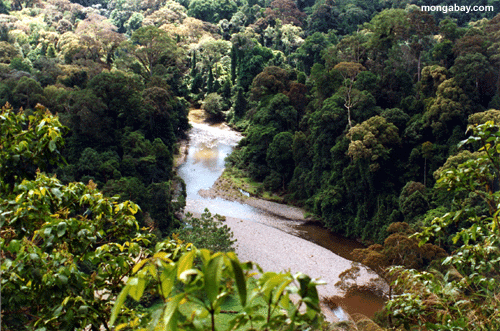|
|
|
|

Tropical rainforests, like the above in Borneo, are exceedingly diverse: some forests may have over 400 species of tree in a single hectare. The rainforest that arose on Ascension Island over the past 150 years has considerably fewer species than an older ecosystem. Nevertheless, scientists were surprised by how quickly a complex forest took root on the island.
|
Fasting-growing man-made rainforest may change leading ecological theory
Man-made rainforest baffles scientists
By Charles Arthur Technology Editor
16 September 2004
Original Source
A Man-Made rainforest that should have taken millennia to evolve has baffled scientists by springing up in just 150 years.
Rainforests should take millions of years to develop the highly complex, interactive ecosystems for which they are famed, in which every species fills an essential niche.
But the forest on Green Mountain, Ascension Island, in the mid-Atlantic sprung up chaotically from a mixed bag of botanical scrap brought in by the Royal Navy in 1843.
And the introduced species have thrived at a rate that has stunned experts and could trigger a rethink of conventional ecological theory, New Scientist magazine reports today.
When Charles Darwin stopped off at Ascension Island in 1836 on the home stretch of his long journey on the Beagle, he described it then as "entirely destitute of trees". Lying 1,200 miles from the nearest continent, the volcanic island was almost barren because of its remoteness, with only about 20 plant species, mainly ferns.
But in 1843, an ambitious British scheme for revitalising the island began, with Royal Navy troops planting thousands of trees a year, using seedlings from Argentina, South Africa, and the Royal Botanical Gardens at Kew.
Soon the bare white mountain was cloaked in vegetation and renamed Green Mountain. By the early 20th century the mountain's slopes were covered in guava, banana, wild ginger, the white-flowered Cleroden drum, Madagascan periwinkle and eucalyptus from Australia. A thick bamboo forest crowned the summit.
Now Green Mountain is a thriving tropical forest, yet it grew from species collected randomly. Conventional theory suggests complex ecosystems only emerge through a slow evolution in which different organisms develop in tandem to fill particular niches.
But Green Mountain suggests that natural rainforests may be constructed more by chance than by evolution.
Dissident theorists call this "ecological fitting". It says species do not so much evolve to create ecosystems as make the best of what they have.
"The Green Mountain system is a spectacular example of ecological fitting," David Wilkinson, from Liverpool John Moores University, told New Scientist. "It is a man-made system that has produced a tropical rainforest without any co-evolution between its constituent species."
But Alan Gray, an ecologist at the University of Edinburgh, argues that the few surviving endemic species on Green Mountain would still be co-evolving and may form the framework of the new ecosystem, meaning the newcomers may be structurally irrelevant.
Even the new species may not be such a random collection.
"Many of the imports may have come from the same place, importing their co-evolutionary relationships," said Gray.
�2004 Independent Digital (UK) Ltd. All rights reserved
CONTENT COPYRIGHT Independent Digital (UK) Ltd. THIS CONTENT IS INTENDED SOLELY FOR EDUCATIONAL PURPOSES.
mongabay.com users agree to the following as a condition for use of this material:
This site contains copyrighted material the use of which has not always been authorized by the copyright owner. Such material is made available in an effort to advance understanding of environmental issues. This constitutes 'fair use' of any such copyrighted material as provided for in section 107 of the US Copyright Law. In accordance with Title 17 U.S.C. Section 107, the material on this site is distributed without profit. If you wish to use copyrighted material from this site for purposes of your own that go beyond 'fair use', you must obtain permission from the copyright owner.
If you are the copyright owner and would like this content removed from mongabay.com, please contact me.
|